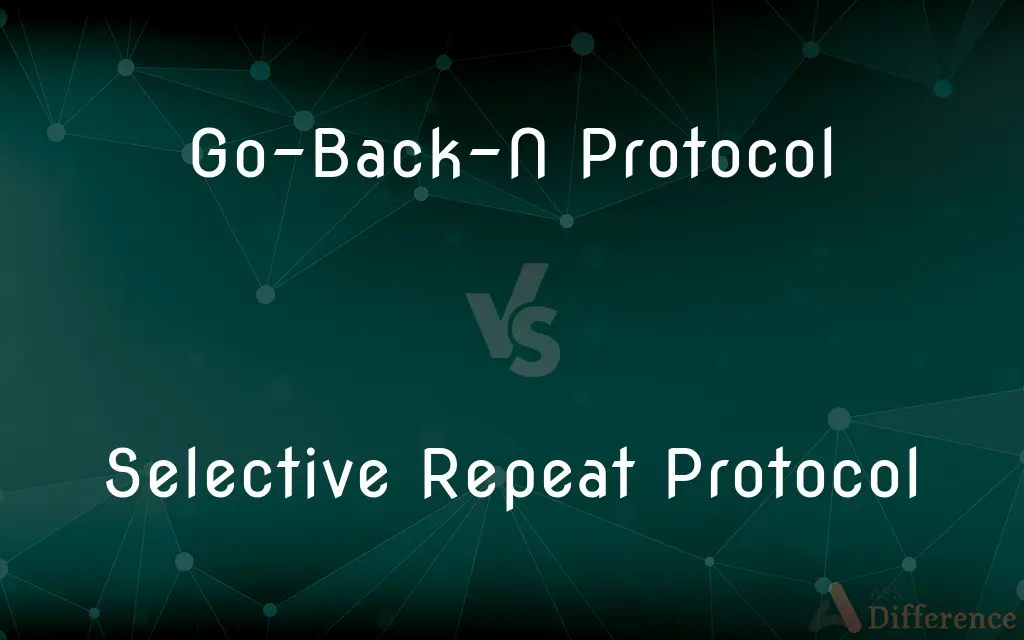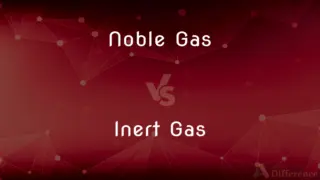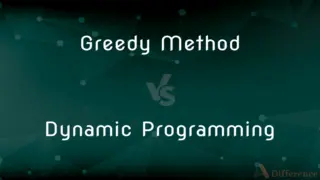Go-Back-N Protocol vs. Selective Repeat Protocol — What's the Difference?
By Tayyaba Rehman — Published on January 6, 2024
Go-Back-N Protocol involves resending all frames after a lost one, while Selective Repeat Protocol resends only the missing frame.

Difference Between Go-Back-N Protocol and Selective Repeat Protocol
Table of Contents
ADVERTISEMENT
Key Differences
In the Go-Back-N Protocol, when an error is detected, all frames sent after the erroneous one are resent. This is less efficient but simpler to implement. The Selective Repeat Protocol, by contrast, resends only the specific frame that was lost or corrupted, making it more efficient but also more complex.
Error handling in Go-Back-N Protocol is straightforward, as the receiver simply discards all frames after the first error. In Selective Repeat Protocol, the receiver maintains a buffer to store out-of-order frames, which are kept until missing frames are received.
Flow control in Go-Back-N Protocol is managed by allowing a fixed number of unacknowledged frames. Selective Repeat Protocol, however, allows for more flexible flow control since only specific frames are resent.
Go-Back-N Protocol is more suitable for channels with lower error rates, as the cost of resending multiple frames is less significant. Selective Repeat Protocol is ideal for unreliable channels, where resending only specific frames is more efficient.
In terms of implementation, Go-Back-N Protocol is simpler and requires less memory than Selective Repeat Protocol, as the latter needs additional mechanisms to handle the selective acknowledgments and buffering of frames.
ADVERTISEMENT
Comparison Chart
Error Recovery
Resends all frames after an error.
Resends only the erroneous frame.
Efficiency
Less efficient with higher error rates.
More efficient, especially on unreliable channels.
Implementation Complexity
Simpler, less memory-intensive.
More complex, requires additional buffering.
Suitability
Better for lower error rates.
Ideal for higher error rates.
Receiver Operation
Discards frames after error until retransmission.
Maintains buffer for out-of-order frames.
Compare with Definitions
Go-Back-N Protocol
It uses a window to limit the number of unacknowledged frames in the network.
The Go-Back-N Protocol efficiently manages network congestion with its window size.
Selective Repeat Protocol
It provides more efficient error correction by targeting specific error frames.
The targeted error correction in Selective Repeat Protocol minimizes data traffic.
Go-Back-N Protocol
In this protocol, error detection leads to the resending of a sequence of frames.
The Go-Back-N Protocol ensures reliable data transmission even in the presence of frame losses.
Selective Repeat Protocol
Selective Repeat is more complex but offers higher efficiency on error-prone channels.
Despite its complexity, Selective Repeat Protocol excels in environments with frequent transmission errors.
Go-Back-N Protocol
Go-Back-N Protocol is a sliding window protocol for error recovery in data transmission.
In Go-Back-N Protocol, if the fourth frame is lost, frames four to seven are resent.
Selective Repeat Protocol
It uses individual acknowledgments for each frame, enhancing efficiency.
Selective Repeat Protocol's individual acknowledgments prevent unnecessary retransmissions.
Go-Back-N Protocol
Go-Back-N Protocol requires the receiver to send cumulative acknowledgments.
Go-Back-N Protocol's use of cumulative acknowledgments simplifies the receiver's process.
Selective Repeat Protocol
Selective Repeat Protocol allows selective retransmission of erroneous or lost frames.
In Selective Repeat Protocol, only the third frame is resent if it's the only one missing.
Go-Back-N Protocol
Go-Back-N is less complex but can be inefficient on unreliable channels.
The Go-Back-N Protocol, while easier to implement, may not be optimal for high-error networks.
Selective Repeat Protocol
This protocol maintains a buffer for out-of-order frames until missing ones arrive.
Selective Repeat Protocol's buffering allows for quicker assembly of the complete message.
Common Curiosities
Is Go-Back-N Protocol suitable for high-error networks?
It's less suitable for high-error networks due to the inefficiency of resending multiple frames.
Can Go-Back-N Protocol handle out-of-order frames?
No, it cannot handle out-of-order frames; it resends from the point of error.
What is the Go-Back-N Protocol?
It's a sliding window protocol that resends a sequence of frames after detecting an error.
What makes Selective Repeat Protocol more efficient?
Its efficiency comes from resending only the specific frames that were lost or corrupted.
Which protocol is simpler to implement?
Go-Back-N Protocol is simpler to implement due to its less complex mechanism.
How do acknowledgments work in Go-Back-N Protocol?
It uses cumulative acknowledgments for a sequence of frames.
How does Selective Repeat Protocol differ from Go-Back-N?
Selective Repeat resends only the erroneous frames, unlike Go-Back-N which resends all frames after an error.
Does Selective Repeat Protocol require more memory?
Yes, it requires more memory for buffering out-of-order frames.
Does Go-Back-N require additional buffering?
No, it does not require additional buffering like Selective Repeat.
In which scenario is Go-Back-N more efficient?
It's more efficient in scenarios with lower error rates.
How does error recovery differ in these protocols?
Go-Back-N resends a block of frames, while Selective Repeat targets specific frames.
Are individual acknowledgments used in Selective Repeat Protocol?
Yes, each frame is individually acknowledged in this protocol.
Can Selective Repeat handle higher error rates effectively?
Yes, it's more effective in environments with higher error rates.
Is flow control more flexible in Selective Repeat Protocol?
Yes, it allows more flexible flow control due to selective retransmissions.
What is the main advantage of Selective Repeat Protocol?
Its main advantage is the efficient handling of frame errors with minimal retransmissions.
Share Your Discovery

Previous Comparison
Noble Gas vs. Inert Gas
Next Comparison
Greedy Method vs. Dynamic ProgrammingAuthor Spotlight
Written by
Tayyaba RehmanTayyaba Rehman is a distinguished writer, currently serving as a primary contributor to askdifference.com. As a researcher in semantics and etymology, Tayyaba's passion for the complexity of languages and their distinctions has found a perfect home on the platform. Tayyaba delves into the intricacies of language, distinguishing between commonly confused words and phrases, thereby providing clarity for readers worldwide.













































